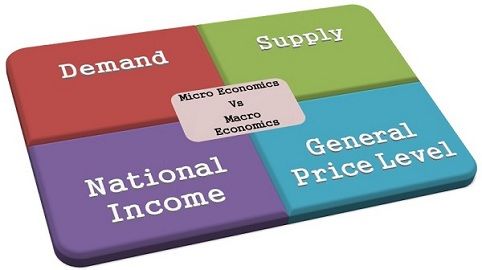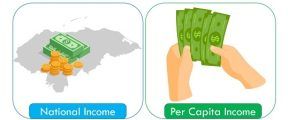 Micro Economics talks about the actions of an individual unit, i.e. an individual, firm, household, market, industry, etc. On the other hand, the Macro Economics studies the economy as a whole, i.e. it assesses not a single unit but the combination of all i.e. firms, households, nation, industries, market, etc.
Micro Economics talks about the actions of an individual unit, i.e. an individual, firm, household, market, industry, etc. On the other hand, the Macro Economics studies the economy as a whole, i.e. it assesses not a single unit but the combination of all i.e. firms, households, nation, industries, market, etc.
‘Economics’ is defined as the study of how humans work together to convert limited resources into goods and services to satisfy their wants (unlimited) and how they distribute the same among themselves. Economics has been divided into two broad parts i.e. Micro Economics and Macro Economics. There are two broad categories into which Economics is classified, i.e. Micro Economics and Macro Economics.
Here, in the given article we’ve broken down the concept and all the important differences between microeconomics and macroeconomics, in tabular form, have a look.
Contents: Micro Economics Vs Macro Economics
Comparison Chart
| Basis for Comparison | Microeconomics | Macroeconomics |
|---|---|---|
| Meaning | The branch of economics that studies the behavior of an individual consumer, firm, family is known as Microeconomics. | The branch of economics that studies the behavior of the whole economy, (both national and international) is known as Macroeconomics. |
| Deals with | Individual economic variables | Aggregate economic variables |
| Business Application | Applied to operational or internal issues | Environment and external issues |
| Tools | Demand and Supply | Aggregate Demand and Aggregate Supply |
| Assumption | It assumes that all macro-economic variables are constant. | It assumes that all micro-economic variables are constant. |
| Concerned with | Theory of Product Pricing, Theory of Factor Pricing, Theory of Economic Welfare. | Theory of National Income, Aggregate Consumption, Theory of General Price Level, Economic Growth. |
| Scope | Covers various issues like demand, supply, product pricing, factor pricing, production, consumption, economic welfare, etc. | Covers various issues like, national income, general price level, distribution, employment, money etc. |
| Importance | Helpful in determining the prices of a product along with the prices of factors of production (land, labor, capital, entrepreneur etc.) within the economy. | Maintains stability in the general price level and resolves the major problems of the economy like inflation, deflation, reflation, unemployment and poverty as a whole. |
| Limitations | It is based on unrealistic assumptions, i.e. In microeconomics it is assumed that there is a full employment in the society which is not at all possible. | It has been analyzed that 'Fallacy of Composition' involves, which sometimes doesn't proves true because it is possible that what is true for aggregate may not be true for individuals too. |
Definition of Micro Economics
Microeconomics is the branch of economics that concentrates on the behaviour and performance of the individual economic agents within the economy such as consumers, family, industry, firms, etc. It ascertains how the limited resources are allocated among various individuals to satisfy their wants? As well as it specifies the conditions for the best possible utilization of the resources, in order to attain maximum output and social welfare.
Here, the demand plays a key role in determining the quantity and the price of a product along with the price and quantity of related goods (complementary goods) and substitute products, so as to make a judicious decision regarding the allocation of scarce resources, concerning their alternative uses.
Microeconomics analyzes how individuals and households spend their income? How do people decide what amount to save for future contingencies? What set of goods and services best fulfils their needs and wants, in the limited income?
It also determines what products and how many products the firm should manufacture to sell? At what price the firm should offer its goods and services to the target audience? What sources of finance are to be used by the firm to commence or operate the business? How many and at what rate the workers are to be hired to work for the firm? When should the firm expand, downsize and close the business?
Definition of Macro Economics
In macroeconomics, the entire economic phenomena or the overall economy is talked about. Basically, it focuses on the behaviour and performance of aggregate variables and those issues which affect the whole economy.
It includes regional, national and international economies and covers the major areas of the economy like unemployment, poverty, general price level, total consumption, total savings, GDP (Gross Domestic Product), imports and exports, economic growth, globalisation, monetary/ fiscal policy, etc.
Here we discuss, how the equilibrium is attained as a result of changes in the macroeconomic variables. It ascertains the level of economic activity in the economy? What is the rate of unemployment, poverty and inflation in the country? What are the issues that result in speeding up or slowing down of the economy? What is the standard of living of people in the country? What is the cost of living in the country?
Further, macroeconomics not only discusses issues with which the economy goes through but also helps in resolving them, thereby enabling it to function efficiently.
Key Differences between Micro and Macro Economics
The points given below explains the difference between micro and macro economics in detail:
- Microeconomics studies the particular segment of the economy, i.e. an individual, household, firm, or industry. It studies the issues of the economy at an individual level. On the other hand, Macroeconomics studies the whole economy, that does not talk about a single unit rather it studies aggregate units, such as national income, general price level, total consumption, etc. It deals with broad economic issues.
- Microeconomics stresses on individual economic units. As against this, the focus of macroeconomics is on aggregate economic variables.
- Microeconomics is applied to operational or internal issues, whereas environmental and external issues are the concern of macroeconomics.
- The basic tools of microeconomics are demand and supply. Conversely, aggregate demand and aggregate supply are the primary tools of macroeconomics.
- Microeconomics deals with an individual product, firm, household, industry, wages, prices, etc. Conversely, Macroeconomics deals with aggregates like national income, national output, price level, total consumption, total savings, total investment, etc.
- Microeconomics covers issues like how the price of a particular commodity will affect its quantity demanded and quantity supplied and vice versa. In contrast, Macroeconomics covers major issues of an economy like unemployment, monetary/ fiscal policies, poverty, international trade, inflationary increase in prices, deficit, etc.
- Microeconomics determine the price of a particular commodity along with the prices of complementary and the substitute goods, whereas the Macroeconomics helps maintain the general price level, as well as it helps in resolving major economic issues like inflation, deflation, disinflation, poverty, unemployment, etc.
- While analysing any economy, microeconomics takes a bottom-up approach, whereas the macroeconomics considers a top-down approach.
Video: Micro Economics Vs Macro Economics
Micro Economics
Pros:
- It helps in the determination of prices of a particular product and also the prices of various factors of production, i.e. land, labour, capital, organisation and entrepreneur.
- It is based on a free enterprise economy, which means the enterprise is independent to take decisions.
Cons:
- The assumption of full employment is completely unrealistic.
- It only analyses a small part of an economy while a bigger part is left untouched.
Macro Economics
Pros:
- It helps determine the balance of payments along with the causes of deficit and surplus of it.
- It helps in deciding the economic and fiscal policies and solves the issues of public finance.
Cons:
- Its analysis says that the aggregates are homogeneous, but it is not so because sometimes they are heterogeneous.
- It covers only the aggregate variables which avoid the welfare of the individual.
Interdependency
As microeconomics focuses on the allocation of limited resources among the individuals, the macroeconomics examines that how the distribution of limited resources is to be done among many people, so that it will make the best possible use of the scarce resources. As microeconomics studies about the individual units, at the same time, macroeconomics studies about the aggregate variables.
Both are of the view that the nation’s economic welfare is possible only when there is the best possible utilization of productive resources. In this way, we can say that they are interdependent. Further, to have a full understanding of economics, the study of both the two branches is pertinent.
Conclusion
Micro and Macro Economics are neither different subjects, nor they are contradictory, rather, they are complementary. As every coin has two aspects – micro and macroeconomics are also the two aspects of the same coin, wherein one’s demerit is others merit and in this way, they cover the whole economy. The only important point which makes them different is the area of application.






khiuramlung says
Great thanks to all the concerned members of the same……I gain lots of knowledge through this article.
VIOLA says
indeed this is satisfactory
Shubham Jain says
its great………… I have gained a lot of knowledge and ideas which i don’t have before
thank you for such a fantastic article
Nazmus Sakib says
I gain ample knowledge through this article.
ANONYMOUS says
Good article
Surbhi S says
Thank you all, we really value your opinions.
Kaspersuresh says
Thank you, really good
yash says
this really helped me…today is my test on micro and macro economics
Sowndar says
Thanks for the detailed answer I gained got knowledge about micro and macroeconomics …….thank you once again
jennifer theron says
great article with very useful information thanks
Rishabh Bhatt says
Now I can better explain anyone.
Hitashree priyadarshini says
Great..this is really helpful for me…
chidi says
Great knowledge shared. Thanks a lot!
Gurdas says
Thanks
This is great full for me
And easly to understand for me
Surbhi S says
To all the readers, Thank you so much for sharing your views and appreciating the article. It motivates us to do better. Keep visiting. 🙂
sapna says
superb ..good knowledge and easily understandable
thanks a lot .
Tai Chinh says
It’s great. Thank you very much
p karri says
very useful blog i learnt some thing new very easily
vinish parikh says
Nicely Explained as the majority of economic students gets confused between both the terms, but you have explained this topic very well. Thanks for sharing the article.
brian onesmus says
good work……well understood.thanks.
Raz Mohammad likhon says
It’s great. Nicely explained all the topic. I understand very easily. Thanks a lot.
sunil Kumar says
The best thing is that you have explained each and everything in simple words which is easy to understand to everyone.
Nellie says
Thanks for a simple clarification
shirtivate says
This was really useful, Thank you
chad thomas says
this was very helpful
Sam says
This is very helpful to me
Abhishek Chaudhary says
This is very helpful
esmaaih says
I thank yuo so much ,as I understanding these two aspects of economic
lio surya says
This is very useful to me
vm engineeers says
very useful
Sumit says
Nice content . You got a new subscriber